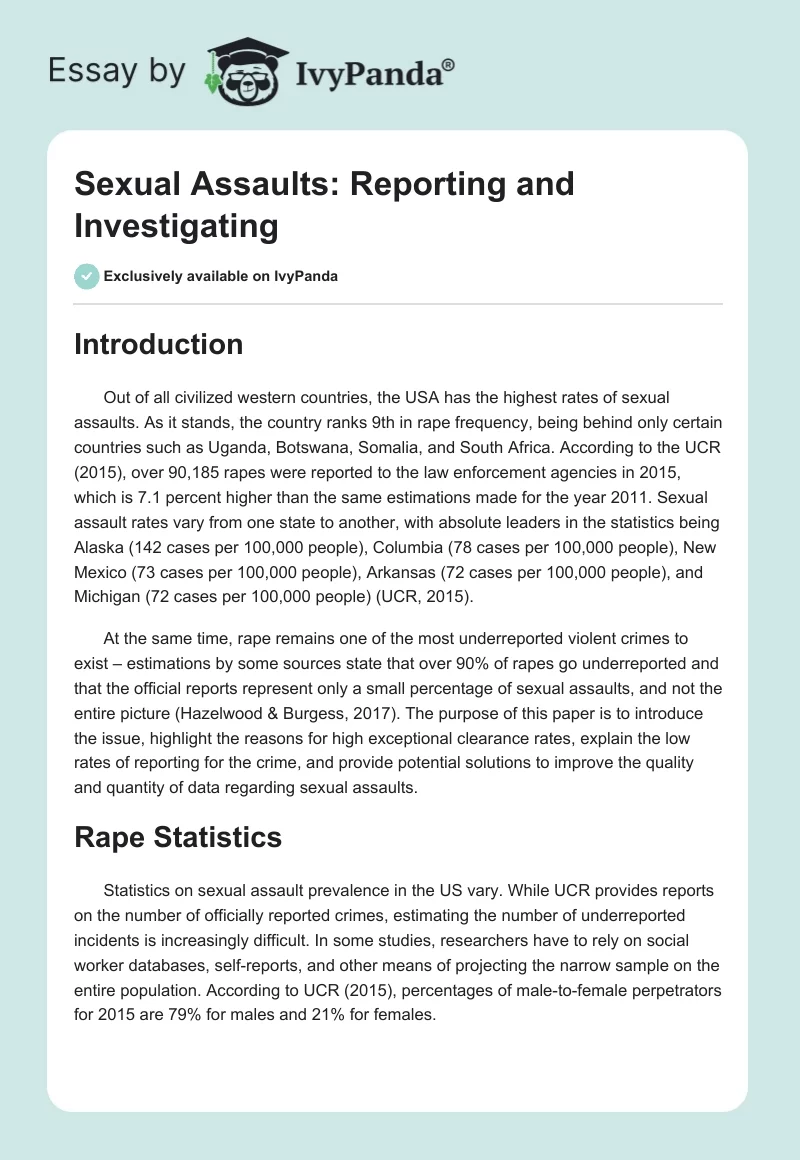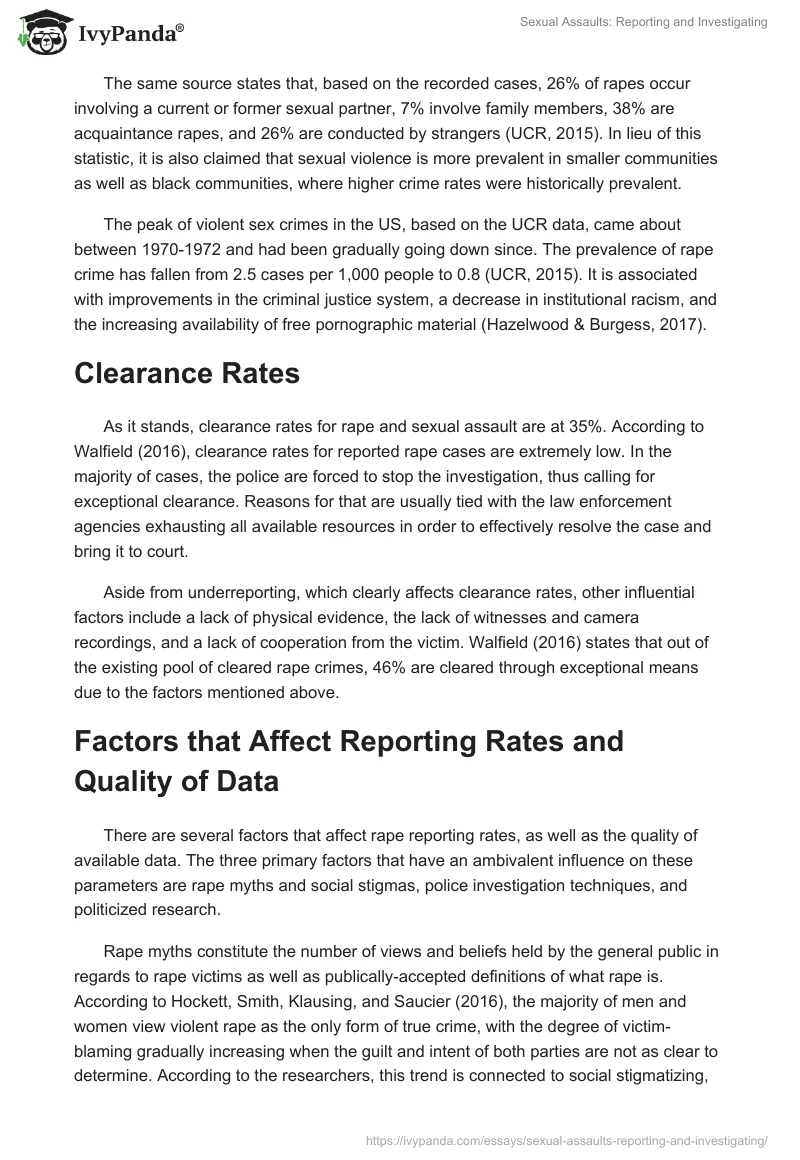Introduction
Out of all civilized western countries, the USA has the highest rates of sexual assaults. As it stands, the country ranks 9th in rape frequency, being behind only certain countries such as Uganda, Botswana, Somalia, and South Africa. According to the UCR (2015), over 90,185 rapes were reported to the law enforcement agencies in 2015, which is 7.1 percent higher than the same estimations made for the year 2011. Sexual assault rates vary from one state to another, with absolute leaders in the statistics being Alaska (142 cases per 100,000 people), Columbia (78 cases per 100,000 people), New Mexico (73 cases per 100,000 people), Arkansas (72 cases per 100,000 people), and Michigan (72 cases per 100,000 people) (UCR, 2015).
At the same time, rape remains one of the most underreported violent crimes to exist – estimations by some sources state that over 90% of rapes go underreported and that the official reports represent only a small percentage of sexual assaults, and not the entire picture (Hazelwood & Burgess, 2017). The purpose of this paper is to introduce the issue, highlight the reasons for high exceptional clearance rates, explain the low rates of reporting for the crime, and provide potential solutions to improve the quality and quantity of data regarding sexual assaults.
Rape Statistics
Statistics on sexual assault prevalence in the US vary. While UCR provides reports on the number of officially reported crimes, estimating the number of underreported incidents is increasingly difficult. In some studies, researchers have to rely on social worker databases, self-reports, and other means of projecting the narrow sample on the entire population. According to UCR (2015), percentages of male-to-female perpetrators for 2015 are 79% for males and 21% for females.
The same source states that, based on the recorded cases, 26% of rapes occur involving a current or former sexual partner, 7% involve family members, 38% are acquaintance rapes, and 26% are conducted by strangers (UCR, 2015). In lieu of this statistic, it is also claimed that sexual violence is more prevalent in smaller communities as well as black communities, where higher crime rates were historically prevalent.
The peak of violent sex crimes in the US, based on the UCR data, came about between 1970-1972 and had been gradually going down since. The prevalence of rape crime has fallen from 2.5 cases per 1,000 people to 0.8 (UCR, 2015). It is associated with improvements in the criminal justice system, a decrease in institutional racism, and the increasing availability of free pornographic material (Hazelwood & Burgess, 2017).
Clearance Rates
As it stands, clearance rates for rape and sexual assault are at 35%. According to Walfield (2016), clearance rates for reported rape cases are extremely low. In the majority of cases, the police are forced to stop the investigation, thus calling for exceptional clearance. Reasons for that are usually tied with the law enforcement agencies exhausting all available resources in order to effectively resolve the case and bring it to court.
Aside from underreporting, which clearly affects clearance rates, other influential factors include a lack of physical evidence, the lack of witnesses and camera recordings, and a lack of cooperation from the victim. Walfield (2016) states that out of the existing pool of cleared rape crimes, 46% are cleared through exceptional means due to the factors mentioned above.
Factors that Affect Reporting Rates and Quality of Data
There are several factors that affect rape reporting rates, as well as the quality of available data. The three primary factors that have an ambivalent influence on these parameters are rape myths and social stigmas, police investigation techniques, and politicized research.
Rape myths constitute the number of views and beliefs held by the general public in regards to rape victims as well as publically-accepted definitions of what rape is. According to Hockett, Smith, Klausing, and Saucier (2016), the majority of men and women view violent rape as the only form of true crime, with the degree of victim-blaming gradually increasing when the guilt and intent of both parties are not as clear to determine. According to the researchers, this trend is connected to social stigmatizing, which prevents the majority of rape victims from reporting crimes committed against them.
The issue of rape myths has a connection with how the police treat rape victims. Many victims claim that their stories are met with skepticism rather than compassion, which further dilutes the desire to get law enforcement involved. According to Venema (2014), law enforcement agencies currently utilize a schema approach, which involves the analysis of rape allegations based on the existing database of crimes, looking for comparisons and similarities.
The majority of police training manuals provide case studies of particular incidents in order to train police officers to detect and identify cases that are potentially false. Hazelwood and Burgess (2017) further expand on the set of measures and techniques available to police officers, these being cross-examinations, psychological analysis, and polygraph testing of both the alleged victim and the perpetrator.
They also make a point that circumstances alone are often not enough to determine whether a report was true or false, offering examples of cases where similar situations led to completely different conclusions. Venema (2014) supports these notions by stating that many of the reported rape accusations turn out to be fabricated, born out of panic or need for attention.
Lastly, there is the issue of politics involved, as rape crimes serve as a pivotal point for individuals and movements that seek change within the existing political system, the criminal justice system, and society in general. According to Prindle (2018), many social and feminist researchers tend to overstate their case and utilize statistically inaccurate means of gathering and analyzing data in order to push forward the notion of a “rape society.”
As an example, Prindle (2018) presents research conducted among the students of Texas University, which utilized questionable techniques as well as led its participants towards desirable answers in order to increase the percentage of alleged underreported sexual assaults. Prindle (2018) states that between the government purposefully reducing the numbers in order to avoid social tensions and feminist researchers altering data in order to make it seem more prevalent, it is hard to determine the actual scope of the issue.
How to Make Data More Accurate?
Based on the evidence presented above, I will voice two statements, which may be seen as unpopular. Firstly, the data currently available through UCR is inaccurate. Sexual violence rates are much higher than these numbers suggest but are lower than what social researchers estimate it to be. Secondly, there is no way of making data significantly more accurate than it already is.
As it is possible to see, there are too many variables that significantly affect the accuracy of the data, ranging from the willingness to report to the definition of rape and ending with rape myths, issues of false reporting, and political interference. Rape crimes will always remain a volatile social and criminal issue, which would affect the quality of data. The solution, in my opinion, is to shift focus from determining exact numbers to preventing rape through educational and social reforms.
References
Hazelwood, R. R., & Burgess, A. W. (Eds.). (2017). Practical aspects of rape investigation (5th ed.). New York, NY: CRC Press.
Hockett, J. M., Smith, S. J., Klausing, C. D., & Saucier, D. A. (2016). Rape myth consistency and gender differences in perceiving rape victims: A meta-analysis. Violence Against Women, 22(2), 139-167.
Prindle, D. F. (2018). The University of Texas “rape survey”: A case study of politicized social science. Academic Questions, 31(1), 77-83.
UCR. (2015). Rape. Web.
Venema, R. M. (2014). Police officer schema of sexual assault reports: Real rape, ambiguous cases, and false reports. Journal of Interpersonal Violence, 31(5), 872-899.
Walfield, S. M. (2016). When a cleared rape is not cleared: A multilevel study of arrest and exceptional clearance. Journal of Interpersonal Violence, 31(9), 1767-1792.


